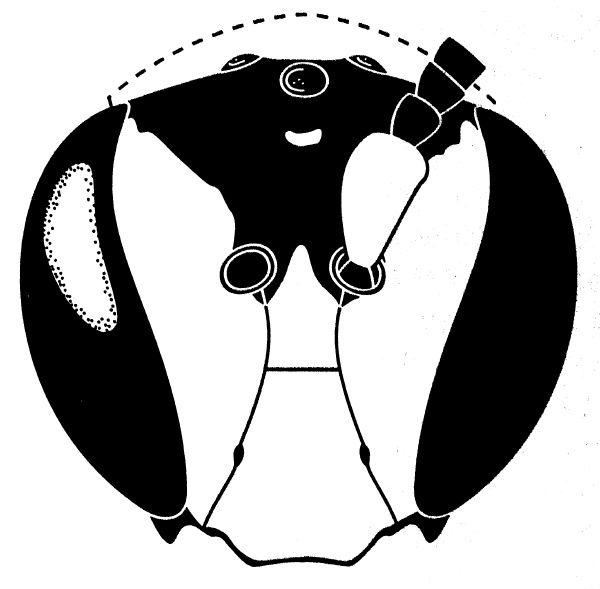Hylaeus in Hawaii

Hylaeus in Hawaii |

|
Hylaeus hilarisIslands: Molokai, Lanai, MauiLocations: Molokai (Moomomi) Habitats: Coast. No recent collections from Maui or Lanai. Plants: None Xerces: Hylaeus hilaris is a cleptoparasitic coastal bee endemic to the islands of Molokai, Lanai, and Maui in Hawaii. It is distinguished by the reddish abdomen with white apical hair bands and the mostly yellow face of the male. Never abundant, it is now extremely rare and has been recently collected only at a single site on Molokai. Species Profile 
Insects of Hawaii: Medium-sized cleptoparasitic bees with clear wings, red basal terga, and unusual pale hair bands on apical terga (may be indistinct or lost by abrasion). Male lower face entirely yellow, extended at sides in a broad stripe above antennal sockets, scape moderately dilated and pale yellow. Female paraocular areas not marked, face and antennae more or less red, clypeus emarginate, fore tarsus with straight hair. See discussion of cleptoparasites in remarks. Colors of the integument and pubescence of the female are based on an old specimen. Perkins (1899:106; 1913:lxxx) discovered five species in which the females have short, straight hair on the fore tarsi and considered them closely allied: H. hilaris, H. hostilis, H. inquilina, H. sphecodoides, and H. volatilis. He associated the straight tarsal hair with cleptoparasitic habits. At least the basal metasomal segments of both sexes are typically red to reddish brown in H. hilaris and H. hostilis, but the segments of H. sphecodoides and H. volatilis may be reddish brown or entirely black in melanic individuals (see remarks for H. volatilis). The metasoma of H. inquilina is always black. Red on the terga is not unique to this group; some unrelated nonparasitic species, such as H. paradoxicus or H. anomalus, also have red terga. Curiously, red terga have evolved repeatedly in different lineages of other cleptoparasitic bees (Michener 2000:31). Females of all the Hawaiian cleptoparasites have the general area of the frons and vertex slightly swollen or convex. With the exception of H. inquilina, female cleptoparasites have a distinctly emarginate clypeus, the facial foveae do not or just barely reach the level of the lateral ocelli, and the fore coxae have a lamellate carina (Fig. 8D; H. hilaris also lacks the lamellate carina). All are usually found in dry habitats – H. hilaris is restricted to the coast and H. inquilina to montane areas, while the remaining three species may be found at nearly all elevations – and appear to parasitize only ground-nesting species. Hylaeus chlorostictus, H. difficilis, H. hirsutulus, H. laetus, H. nivicola, and H. volcanicus are probably the primary hosts in the mountains, and H. assimulans, H. chlorostictus, H. flavifrons, H. flavipes, and H. longiceps serve as hosts at the coast. Insects of Hawaii Volume 17 
UH/DOD: Hylaeus near military lands 
Other: |

|